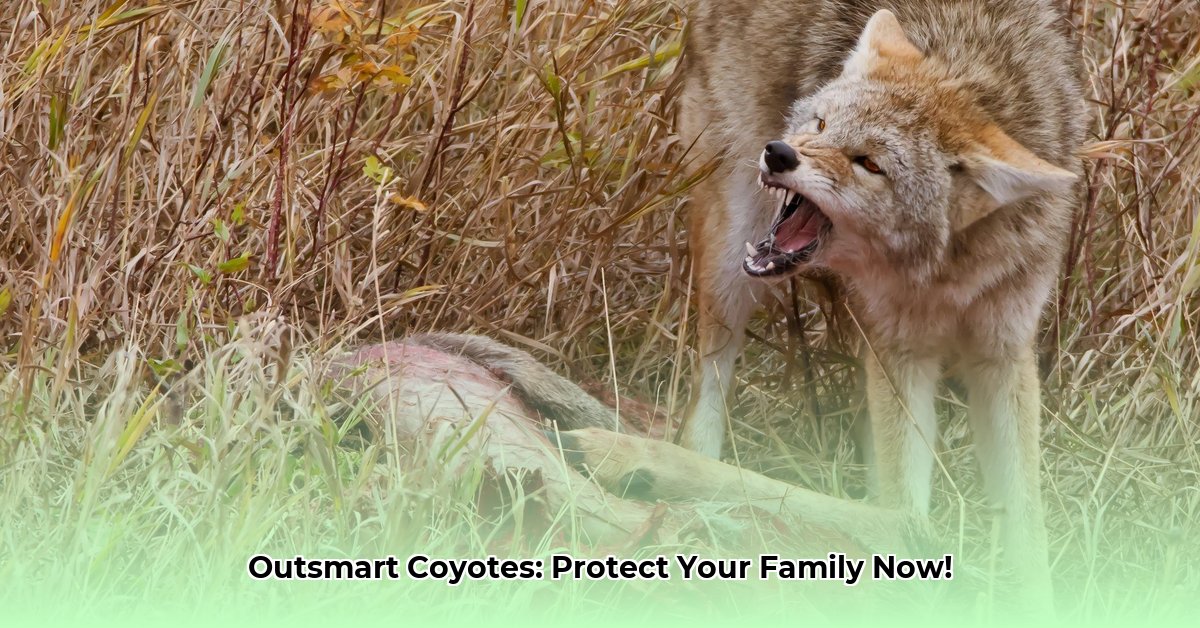Coyotes, once primarily rural dwellers, are now increasingly common in residential areas, raising concerns for homeowners. This comprehensive guide provides proven methods to deter coyotes and create a safer environment for your family, pets, and the surrounding ecosystem. We’ll delve into proactive measures like removing attractants and implementing effective hazing techniques, as well as explore more robust solutions like installing fences and fostering community collaboration. Feeling uneasy about potential coyote encounters? Empower yourself with the knowledge and tools to coexist peacefully with these adaptable creatures.
Understanding Coyote Behavior: Why They Venture into Residential Areas
Before tackling deterrence strategies, it’s crucial to understand what attracts coyotes to our neighborhoods. Coyotes are highly adaptable and intelligent animals driven by their survival instincts. Primarily, they’re seeking food, water, and shelter. Human activity often inadvertently provides all three. Unsecured garbage cans, pet food left outdoors, accessible compost piles, and even fruit-bearing trees can transform a typical yard into a coyote buffet. Dense vegetation, open spaces beneath decks, and unsecured sheds offer inviting shelter. By recognizing these attractants, we can effectively modify our environment to make it less appealing to these opportunistic canines.
Protecting Your Property: Eliminating Attractants
Transforming your property from a coyote haven to a less inviting space involves meticulous attention to eliminating attractants. Think of it as removing the welcome mat for these resourceful creatures.
-
Secure Garbage and Compost: Coyotes possess an exceptionally keen sense of smell, allowing them to detect even faint food odors emanating from garbage bags. Invest in sturdy, tightly sealed garbage containers and store them in a secure location, ideally a garage or shed. Remember, even compost piles, rich in decomposing food scraps, can attract coyotes. Consider using enclosed compost bins or turning your compost regularly to minimize enticing smells.
-
Manage Pet Food and Water: Pet food left outdoors, whether kibble or wet food, acts as a powerful magnet for coyotes. Establish a routine of feeding pets indoors and promptly removing any leftover food and water bowls, especially overnight. This simple step eliminates a readily available food source and can significantly deter coyote visits. Leaving pet food out is akin to setting up a 24/7 diner for coyotes.
-
Clean Up Fallen Fruit and Birdseed: Fallen fruit from trees and scattered birdseed may seem harmless, but they offer effortless meals for coyotes and other wildlife, inadvertently drawing them closer to your home. Regularly clean up fallen fruit and consider using bird feeders designed to minimize seed spillage. You can also temporarily remove feeders during periods of increased coyote activity. Research has demonstrated that readily available food sources significantly contribute to coyote presence in residential areas.
-
Secure Other Food Sources: Think beyond the obvious. Uncleaned grills, uncovered barbecue pits, and even open bags of fertilizer can tempt coyotes with their residual odors. Thoroughly clean grills after each use and store pet food, birdseed, and other potential attractants in tightly sealed containers, ideally indoors.
Effective Hazing Techniques: Asserting Your Territory
Hazing involves using non-lethal methods to scare coyotes away and instill a healthy fear of humans. The goal is to teach them that your property is not a safe or rewarding place to visit. Consistent and assertive hazing is key to long-term success.
-
Make Noise and Be Big: Loud, sudden noises can startle coyotes and break their focus. Shout, clap, bang pots and pans, or use an air horn. Simultaneously, make yourself appear as large and intimidating as possible. Wave your arms, open your jacket wide, and stand tall. This combined approach creates a powerful deterrent. Wildlife experts emphasize the importance of assertive hazing in modifying coyote behavior.
-
Utilize Visual Deterrents: Coyotes are sensitive to visual disturbances. Shine a flashlight directly at a coyote, spray them with a hose, or toss small objects in their direction (without hitting them). These methods create an uncomfortable experience without causing harm, reinforcing the message that your property is off-limits.
-
Install Motion-Activated Devices: Motion-activated sprinklers or lights add an automated layer of protection. These devices startle coyotes with an unexpected spray of water or a sudden burst of light, further discouraging their presence. While effective, keep in mind that coyotes can sometimes habituate to these devices, so it’s helpful to combine them with other hazing techniques.
Building Barriers: Physical Deterrents for Enhanced Protection
Physical barriers offer a robust defense against coyote intrusions by making it more challenging for them to access your property.
-
Install Sturdy Fencing: A well-constructed fence can be a significant deterrent. Aim for a fence at least six feet high, with the bottom edge buried or secured with wire mesh to prevent digging. An angled top section or coyote rollers, which spin when a coyote attempts to climb, further enhance the fence’s effectiveness. Consider this investment a crucial step in safeguarding your property and peace of mind.
-
Eliminate Hiding Places: Coyotes are naturally wary and prefer areas with ample cover. Trim overgrown vegetation, remove brush piles, and secure spaces beneath decks, porches, or sheds. Eliminating these potential hiding spots makes your property less attractive to cautious coyotes.
Community Collaboration: Working Together for a Safer Ecosystem
Individual efforts are amplified when combined with community-wide action. A collaborative approach can create a unified front against coyote intrusions and promote a safer environment for all.
-
Share Information and Strategies: Open communication with your neighbors about coyote sightings, effective deterrent methods, and local regulations is crucial. Sharing knowledge empowers the community to implement consistent hazing strategies and address potential attractants on a broader scale.
-
Organize Neighborhood Clean-ups: Periodic neighborhood clean-up days can significantly reduce attractants across a larger area. Focus on removing garbage, fallen fruit, overgrown vegetation, and other potential food sources to create a less inviting environment for coyotes.
-
Connect with Local Wildlife Authorities: Reach out to your local animal control or wildlife agency for guidance on coyote behavior, safe hazing practices, and reporting procedures for aggressive or sick animals. They can offer valuable resources and support for community-wide coyote management.
By diligently implementing these strategies and fostering a community-minded approach, you can effectively deter coyotes, minimize the risk of encounters, and promote a safer and more harmonious coexistence with these adaptable animals. Remember, consistency, persistence, and community involvement are the cornerstones of successful coyote management.
- Buy Game Patches and Find Collectible Gaming Emblems - December 19, 2025
- The Witcher 3 Modding Guide for Next-Gen Game Enhancements - December 18, 2025
- Witcher 3 Modlist Essential Picks For Your Next-Gen Game - December 17, 2025










